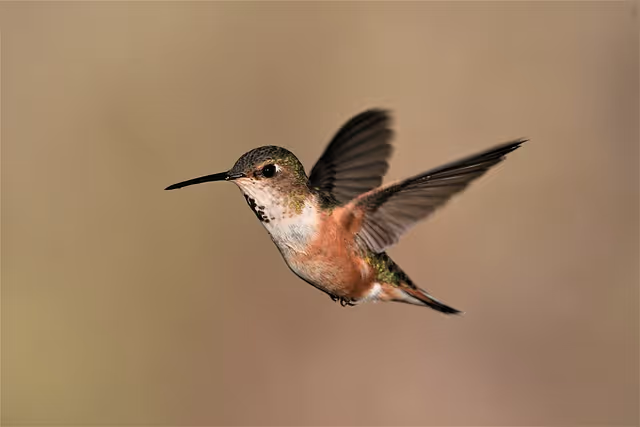Hummingbird Spotlight: The Rufous Hummingbird


Introduction
In late spring, my family and I discovered that a Hummingbird had made a nest in one of the trees in our yard. This set off what turned out to be a lengthy process to try and figure out what species she was. I had initially come to the conclusion that she was a Rufous Hummingbird. However, my family and I found additional information which led to us determining that she was actually an Anna’s Hummingbird. Recently, I wrote a dedicated blog covering Anna’s Hummingbird. Now, its time to give the Rufous Hummingbird some time in the spotlight.
Size, Bills, and Tails
The Rufous Hummingbird (scientific name: Selasphorus rufus) is a fairly small bird that is no larger than a Sparrow. Both males and females are 2.8 to 3.5 inches long (7 to 9 centimeters) and weigh just 0.1 to 0.2 ounces (2 to 5 grams) (1). Their wingspan is 4.3 inches (11 centimeters). They have slender bills that are nearly straight (1). Rufous Hummingbirds also have tails that turn into a point when they are folded, as well as short wings that don’t extend back to the end of the tail when the birds are perched (1).
Color
Male Rufous Hummingbirds are bright orange on their stomachs and backs. They feature red throats are “vivid” and “iridescent” (1). In good lighting conditions, they glow like coals (1). Female Rufous Hummingbirds are green on top with flanks that are “rufous-washed” (1). They also feature green tails that have rufous patches in them (hence the name of the species). Their throats often feature a spot of orange (1).
Fast and Aggressive Birds
Rufous Hummingbirds are blessed with the Hummingbird gifts of being able to move fast, maneuver with “pinpoint” accuracy, and dart when in flight (1). They are aggressive birds that will chase other Hummingbirds away until long after they are tired. This applies not only to Hummingbird species that are smaller than them, but also to Hummingbird species that are bigger than them (1). It even applies when they are in places that are just visiting as part of their migration (1)! They don’t want any other species of Hummingbird to be anywhere near them, and they will work pugnaciously to ensure that they always get the space they desire (1).
Rufous Hummingbirds can flap their wings extremely fast in order to hover in place while in flight. They have been recorded flapping their winds as much as 62 times per second (2).

Image by Daniel Roberts from Pixabay
Range and Habitat
Rufous Hummingbirds typically begin to arrive on the Washington Coast each year in the month of February (4), having journeyed up the Pacific Coast from California and Mexico (2). They tend to stay until August, when most members of the species begin to leave for the winter (4). Some members of the species, particularly adult females and their young, will hang around until September (3, 4). When the birds do depart the coast, they mostly make their way southeast through the Rocky Mountain region. Many Rufous Hummingbirds spend their winters in the Gulf Coast states, though some strays have been reported in other eastern states (3).
Rufous Hummingbirds like to breed in brushy second growth, forest edges, and clearings. Their non-breading habitat includes forest edges, oak and pine forests located at middle to higher levels of elevation, mountain meadows, and streamsides (3). They also like to live in parks and people’s yards (3).
Diet and Feeding
Rufous Hummingbirds like to eat nectar out of tubular flowers They particularly like to eat the nectar that is produced by red tubular flowers, including paintbrush, sage, gilia, and scarlet (3). They usually eat the nectar while they are hovering. To do this, they extend their bills and long tongues deep into the center of the flowers (3).
Rufous Hummingbirds also like to eat tiny insects. They have two methods for catching insects. The first method is to pluck them from foliage by hovering. The second method is to fly out and grab them in midair (3).
Rufous Hummingbirds will also feed on mixtures of sugar and water at Hummingbird feeders. They will hover or perch when eating these mixtures (3). Additionally, they will eat spiders or trapped insects from spider webs from time-to-time (3).
Courtship and Nesting
To attract females, male Rufous Hummingbirds perform courtship display flights. The flights trace a vertical oval or a steep U, climbing very high before diving sharply (3). They make popping and whining sounds at the bottom of their dive. They also buzz back and forth in front of perched females (3). Males can mate with several females (3).
Once a pair is formed, construction of the nest begins. The nest site is normally well concealed in the lower parts of coniferous trees, vines, and deciduous shrubs (3). The nest is typically located 3 to 15 feet (1 to 5 meters) above the ground. However, it can be as high as 30 feet (10 meters) off the ground, particularly later in the season (3). The nest is built by the female, and is typically a compact cup of plant down, spider webs, moss, grasses, and other soft materials. The exterior of the nest is camouflaged with moss and lichens (3).
Eggs and the Young
Rufous Hummingbirds almost always lay two eggs. The eggs are white in color, and hatch within 15-17 days (3). The incubation process is handled exclusively by the female, who is also responsible for feeding the young once they hatch (3). They do this by sticking their bills deep into the mouths of the young and regurgitating small insects. The insects are sometimes mixed with nectar (3). The young typically make their first flight just three weeks after hatching (3).
References
© Ian D. Caldwell, July 2023
Touch whale bones, examine shipwreck artifacts and connect with the coast's living history.

Support our mission, get involved in educational programs, or contribute through donations and volunteering.